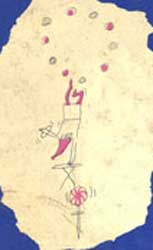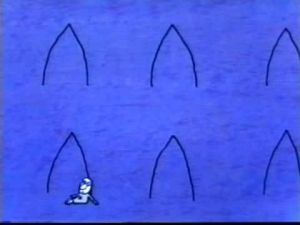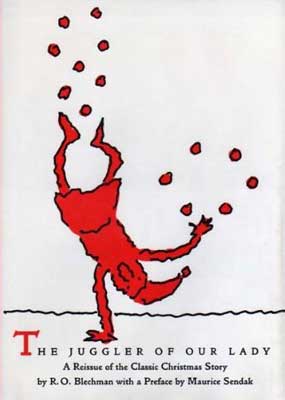Comics /
Spotlight /
Religion and Comics
The Juggler of Our Lady
By Beth Davies-Stofka
August 19, 2010 - 09:10
In 1953, Henry Holt and Co. published the first novel by the legendary cartoonist and animator R. O. Blechman. It was a sweet little book called
The Juggler of Our Lady: A Medieval Legend. It was a graphic novel before there was such a thing. It is still among the finest ever written.
The Juggler is Blechman's adaptation of a Christian story dating to the Middle Ages. It's about a juggler who dearly wants to change the world. Every single day he faithfully goes to town, where he witnesses conflict, strife, and persecution. Every single day the juggler faithfully spreads his carpet on the ground, and juggles.
His juggling is magnificent. He weaves beautiful patterns in the air with balls, hoops, and rings. He juggles right-side up and upside down. He juggles until the blood leaves his limbs. But the uncomprehending world does not notice him, much less respond to his cheerful entertainments.
 |
| A detail from the cover of the 1953 first edition. |
One day the monk (Blechman named him Cantalbert) contemplated his mortality. He realized that everyone dies. And he realized (as all good Catholics do) that he will return to the dust. He decided to enter the monastery, where he could spend the rest of his days showing his love for Mary, the Mother of God.
But he didn't fit in! All the other monks could do things, like cooking and writing and sculpting and teaching. After a time, the prior found a role for Cantalbert. He became the monastery's handyman. And so time passed, until Christmas drew near, and all the monks used their skills and talents to make gifts for Our Lady. Poor sad Cantalbert! Cantalbert had nothing he could give.
On Christmas night, while the other monks slept, Cantalbert crept into the chapel. All night long, he juggled to entertain Mary. In the morning, when the other monks entered the chapel and saw Cantalbert, they denounced him. Sacrilege! Just as they moved to eject Cantalbert from the chapel, he collapsed. But Mary, the Mother of God, stepped off of her altar. In gratitude, she blessed her devoted juggler.
 |
| A still from the 1958 animated cartoon. |
The first beatitude in Jesus' Sermon on the Mount says, "Blessed are the pure in heart, for they will see God." (Matthew 5:8). The medieval story of the juggler was an instructional enterprise, meant to explain the beatitude and keep listeners focused on the Christian big picture. But in Blechman's hands, the story becomes an occasion to explore personal fears, social ills, and the funny side of being human. Yet it remains a story blessed. No longer a teaching tool, it is instead as pure in heart as Cantalbert himself.
Blechman's singular sparse and squiggly lines are infused with such tenderness and humor that it might be easy to miss their profound theological wisdom. His lines are tiny, and they are hesitant. They barely appear on the page, and seem prepared to run away if the reader isn't perfectly still. Divine wisdom, it appears, isn't something handed out by the heavens through ham-handed means. The wisdom of God is something that requires patience, and kindness. It requires us to shut up and listen.
 |
| Pages 1-2 of the novel. First one ball and one hand, then two balls and two hands! |
We give our hearts to Cantalbert because his dedication to us is as fragile as it is generous. Believed by some of the monks to be simple-minded and a fool, we intuit something else. We suspect that Cantalbert has advanced knowledge of the human condition, and he is simply trying to show us. "Don't you get it?" he seems to say. "Let me entertain you!"
Through Cantalbert, Blechman shows us that all the pointless efforts of the entertainers among us – those of the jugglers, cartoonists, poets, tightrope walkers, buskers, and others – are as great in the eyes of God as the widow's mite. These poor and hopeful entertainers give everything of themselves for the sake of showing the world another way to be. It's not something useful, or practical, or profitable. It's something better than that – it is Divine. It is the life-saving counterpoint to America's harsh Puritan realities.
Blechman's Cantalbert always threatens to disappear from the page. It's a familiar feeling. Like us, he is tiny in the face of the world and tiny in the face of the divine. The difference is Heaven thanks him for it.
There are a number of ways to find and read
The Juggler of Our Lady. You can find inexpensive copies of the hardcover edition on the used book market, if you're not too picky about the book's condition. In 1980 the story was reprinted in full but without color by Simon and Schuster in
Behind the Lines, a collection of Blechman's work from the 50s, 60s, and 70s. In 1997 it was reissued again, by Stewart, Tabori, & Chang, and while this is also out of print, you can find used copies.
In 1958, it was adapted into an
animated cartoon, narrated by Boris Karloff.
Enjoy!
Rating: 10 /10
Last Updated: January 17, 2025 - 08:20




